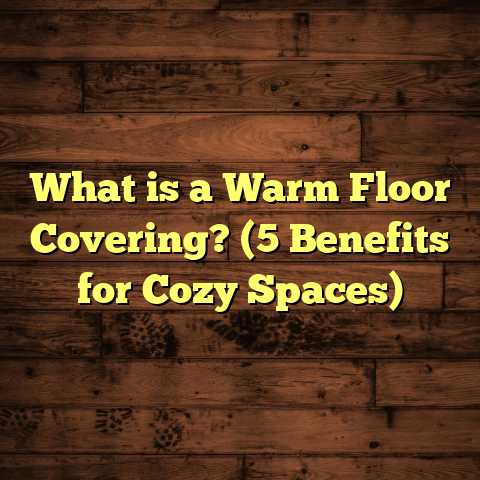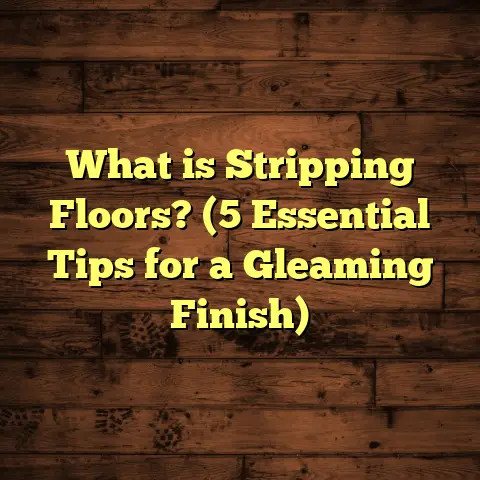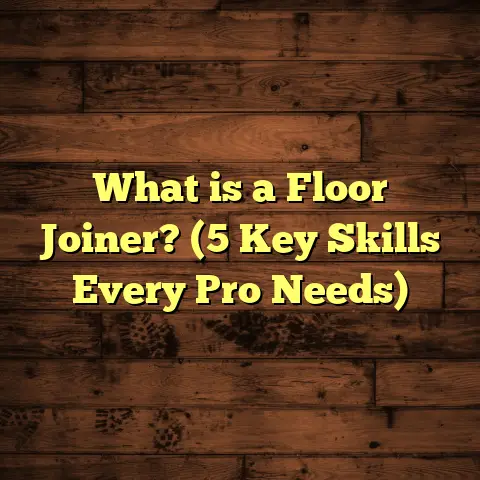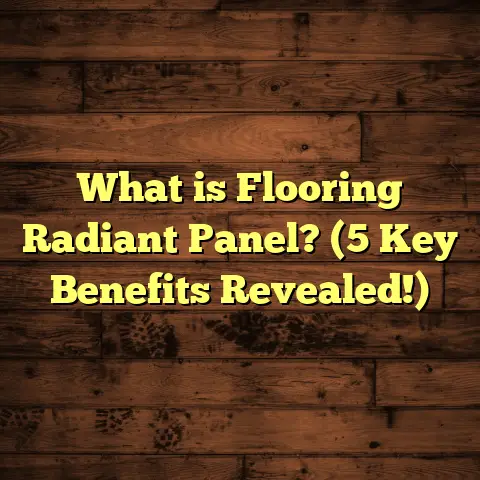What is Fake Wood Flooring Called? (5 Types You Should Know!)
Frustration hits me every time I hear someone say, “I want the beauty of hardwood floors, but I don’t want to deal with the cost or upkeep.” Honestly, I get it. Hardwood flooring looks stunning and adds value to any home, but it doesn’t come cheap. Plus, it requires care and can be vulnerable to moisture, scratches, and dents. For many homeowners, that’s a deal-breaker.
So, what’s the alternative? That’s where fake wood flooring comes into play. But hang on — what exactly is fake wood flooring? And, with so many types out there, how do you know which one fits your needs best? I’ve been in the flooring business for years, helping people navigate this exact dilemma. Let me walk you through what fake wood flooring really means and break down five popular types you should know about.
What is Fake Wood Flooring?
Let’s start simple: fake wood flooring refers to any flooring material designed to look like real hardwood but made from other substances or composites. It’s not solid wood planks but rather alternatives that mimic wood’s look and feel.
Why would someone want fake wood flooring instead of real hardwood? Here are a few reasons:
- Cost: Real hardwood can be expensive to buy and install.
- Durability: Some real wood floors scratch or dent easily.
- Moisture resistance: Hardwood doesn’t handle water well.
- Maintenance: Real wood may need refinishing over time.
- Installation: Hardwood can require professional installation and takes longer.
Fake wood flooring gives you the classic aesthetic of wood, but often with better durability, easier installation, and less maintenance. The materials used vary widely, from synthetic vinyl to engineered layers topped with real wood veneer.
I remember early in my career when a client wanted the warmth of wood in their kitchen but worried about spills damaging hardwood. I introduced them to Luxury Vinyl Plank (LVP), which looks like wood but stands up to moisture. They were thrilled—and it opened my eyes to how diverse “fake wood” options really are.
Over time, I realized these alternatives aren’t just budget-friendly substitutes. Each has unique benefits depending on your specific needs—whether you want waterproof floors for a bathroom or a scratch-resistant surface for a busy family home.
Why Understanding Fake Wood Flooring Matters
Choosing the right flooring is one of the biggest decisions in a home renovation or new build. Floors set the tone for your space’s style and affect your everyday comfort and upkeep time.
Unfortunately, many people lump all fake wood floors together or assume they’re all the same. That leads to surprises like buying laminate for a bathroom only to find it warps after water exposure.
Knowing what each type is made of, how it performs, and what price point it fits into helps you make smarter choices—and avoid costly mistakes.
I’ll share some of my experiences with different materials as we go through each type. Plus, I’ll back up insights with data from industry research and real-world case studies I’ve collected over the years.
1. Laminate Flooring: The Versatile Wood Lookalike
If you’ve ever walked into a home store and seen floors that look like wood but feel different underfoot, it was probably laminate.
Laminate flooring consists of multiple layers:
- A high-density fiberboard (HDF) core made from compressed wood fibers.
- A photographic layer printed with high-resolution images of wood grain.
- A transparent wear layer that protects against scratches and stains.
This layered construction allows laminate to mimic the look of hardwood at a fraction of the cost.
Why Laminate Is So Popular
From my experience installing hundreds of laminate floors, here’s why it’s a go-to choice for many clients:
- Budget-friendly: Laminate typically costs between $1.50 and $5 per square foot. Compared to hardwood’s $8 to $15 range, that’s a big difference.
- Durability: The protective wear layer resists scratches from pets, kids’ toys, and moving furniture.
- Easy installation: Most laminates use click-lock technology that snaps together without glue or nails. This makes it perfect for DIY projects.
- Range of styles: Advances in printing technology have made laminate look incredibly realistic—from classic oak to exotic walnut.
When I installed laminate for a client renovating their basement rec room, they were amazed at how much warmth it added without the hefty hardwood price tag. Plus, because basements can be damp, laminate’s resistance to humidity fluctuations made it a safer choice than solid wood.
Limitations To Keep In Mind
Laminate can’t handle standing water well. If water seeps into seams or underneath boards, it causes swelling and warping. That’s why I never recommend laminate for bathrooms or kitchens with frequent spills unless you’re very diligent about cleanup.
You also won’t get the refinishing option that hardwood offers—once worn out, laminate needs replacing.
Data & Trends on Laminate Flooring
- The global laminate flooring market was valued around $17 billion in 2023.
- It’s expected to grow annually by about 6% as homeowners seek affordable and durable flooring.
- A 2023 survey showed 45% of homeowners choosing laminate did so primarily because of its cost-effectiveness.
- Scratch resistance ratings for laminate floors are often higher than many hardwood finishes.
2. Luxury Vinyl Plank (LVP): Waterproof Wood-Look Flooring
When moisture resistance is a priority but you still want that wood grain look, Luxury Vinyl Plank (LVP) is a standout option. Unlike laminate which has a fiberboard core, LVP is made from layers of synthetic vinyl and plasticizers.
What Makes LVP Different?
- Waterproof: LVP doesn’t swell or warp when exposed to water.
- Comfort: It’s softer underfoot and warmer than tile or stone.
- Realistic texture: Many LVP products have embossed surfaces that mimic the knots and grain of real wood.
- Wide installation options: Can be glued down or floated with click-lock systems.
One memorable job was installing LVP in a lakeside cabin where humidity levels vary wildly. The client loved how the floor stayed perfect despite damp air and occasional spills.
Cost Considerations
LVP generally costs $2.50 to $7 per square foot for materials alone. Installation labor ranges from $1.50 to $3 per square foot professionally.
The vinyl flooring market itself is booming—projected to reach $17 billion globally by 2026—with LVP driving much of this growth due to its versatility.
What You Should Know
LVP handles moisture better than almost any fake wood option but can dent under heavy impact. It also tends to be quieter than laminate because it doesn’t have the hollow sound some laminates produce.
3. Engineered Hardwood: Real Wood Surface with Stability
Engineered hardwood is where things get interesting because it’s technically not fake wood—but it’s often grouped with alternatives due to its hybrid construction.
It features:
- A real hardwood veneer on top (usually 2-6 mm thick)
- Several layers of plywood or high-density fiberboard beneath
This layered design gives engineered hardwood properties real solid wood doesn’t have—mainly better resistance to temperature and humidity changes.
Why I Recommend Engineered Hardwood
From installing it in city condos to suburban homes, I’ve seen engineered hardwood shine when:
- Homeowners want authentic wood aesthetics.
- They live in climates with wide humidity swings.
- They want a floor that can be refinished once or twice.
The veneer layer means you get natural wood grain and texture that looks and feels genuine—something fake printed surfaces can’t fully replicate.
Pricing & Installation
Engineered hardwood typically costs between $4 and $10 per square foot. Labor to install usually runs $3-$5 per square foot due to more involved processes like glue-down or nail-down methods.
It’s more expensive than laminate or vinyl but usually cheaper than solid hardwood while offering many of its advantages.
4. Wood-Look Tile: Durable Porcelain or Ceramic with Wood Grain
Wood-look tile might surprise you because it’s actually ceramic or porcelain tiles printed with detailed wood patterns instead of using real wood or composites.
What Makes Wood-Look Tile Special?
- Ultimate durability: Tiles resist scratches, dents, moisture, and stains.
- Waterproof: Great for any wet area including bathrooms and kitchens.
- Low maintenance: Easy mop-and-go cleaning.
- Variety of finishes: From matte hand-scraped looks to glossy smooth surfaces.
I worked on a commercial retail store where they wanted the warmth of wood without worrying about heavy foot traffic damage. Wood-look tile was perfect there—lasting years with no visible wear.
Price Range & Installation
Tiles range from $3 to $10 per square foot depending on quality and design complexity. Installation is labor-intensive since tiles need precise cutting and grouting—expect $5-$10 per square foot for pro labor.
This makes total costs higher upfront than vinyl or laminate but pays off long-term if you want nearly indestructible floors.
5. Bamboo Flooring: A Natural Alternative That Mimics Hardwood
While bamboo isn’t “fake” since it’s a natural plant-based material, it often gets lumped in as an alternative to traditional hardwoods because it looks similar but grows faster and is more sustainable.
Bamboo floors come in:
- Strand-woven bamboo: Highly compressed fibers creating tough planks.
- Horizontal or vertical grain bamboo: Showcasing different grain patterns.
Why Bamboo Deserves Mentioning
I had a client focused on eco-friendly living who chose bamboo for their whole house. They loved how:
- Bamboo’s hardness rivals some hardwoods.
- Its rapid renewability reduces environmental impact.
- The natural grain patterns add character different from oak or maple.
Bamboo costs typically range from $3 to $8 per square foot with installation costs similar to hardwood ($4-$8 per square foot).
How I Use FloorTally for Project Planning & Budgeting
One challenge I face regularly is managing estimates across so many types of flooring materials and labor costs. Prices vary by region, supplier, installation complexity—you name it!
That’s why I rely on FloorTally. It lets me enter local prices for materials like laminate or LVP plus labor rates specific to my area. The tool calculates total project costs including waste factors so nothing surprises my clients later on.
For instance:
When planning a 1,000 sq ft laminate installation recently:
- FloorTally estimated materials at about $3,000
- Labor at roughly $2,500
- Included a 5% waste factor in material quantities
That clear breakdown helped me present clients with realistic budgets upfront instead of chasing multiple quotes manually—which saves tons of time and builds trust.
Comparing Costs Across Fake Wood Flooring Types
| Flooring Type | Material Cost/sq ft | Installation Cost/sq ft | Total Avg Cost/sq ft | Suitable Areas | Durability |
|---|---|---|---|---|---|
| Laminate | $1.5 – $5 | $1 – $3 | $2.5 – $8 | Living rooms, bedrooms | Good scratch resistance; poor water resistance |
| Luxury Vinyl Plank | $2.5 – $7 | $1.5 – $3 | $4 – $10 | Bathrooms, kitchens | Waterproof; moderate dent resistance |
| Engineered Hardwood | $4 – $10 | $3 – $5 | $7 – $15 | Most rooms | Can be refinished; stable in humidity |
| Wood-Look Tile | $3 – $10 | $5 – $10 | $8 – $20 | Wet areas + high traffic | Extremely durable; waterproof |
| Bamboo | $3 – $8 | $4 – $8 | $7 – $16 | Eco-conscious homes | Hard and durable; natural variation |
Personal Stories & Lessons Learned
Over more than a decade in flooring, here are some things I’ve learned firsthand about fake wood floors:
- One family chose laminate for their kids’ playroom because they wanted something tough yet affordable. After two years of heavy use with no scratches or warping, they were thrilled.
- Another couple picked LVP for their mudroom near the entrance where shoes bring moisture daily. It still looks brand new after three winters with salt, snow, and mud tracked inside.
- I installed engineered hardwood in a historic home renovation where matching original wood floors was critical. The veneer layer gave an authentic appearance while preventing cupping caused by humidity swings.
- Wood-look tile saved the day for a restaurant owner who needed stylish floors able to withstand constant spills and heavy foot traffic without losing charm.
- For an eco-minded client building an off-grid cabin, bamboo was perfect because it offered natural beauty alongside sustainability credentials they valued deeply.
How Do You Decide Which Fake Wood Floor Is Right For You?
Ask yourself these questions:
- Where will the floor go? Moisture-prone areas need waterproof options like LVP or tile.
- What’s your budget? Laminate offers great looks for less money; engineered hardwood costs more but has real wood on top.
- How much wear will the floor get? Pets and kids mean durability matters—laminate or vinyl tend to hold up well.
- Do you want authentic wood grain? Engineered hardwood offers genuine texture; printing tech improves but can’t fully replicate real wood feel.
- Are you concerned about environmental impact? Bamboo is renewable; vinyl less so but advances continue in recycling technologies.
Final Thoughts (But Not Really Final!)
Fake wood flooring offers many options tailored to different lifestyles, budgets, and tastes. Whether you pick laminate for affordability or engineered hardwood for authenticity—or even wood-look tile for durability—there’s something out there designed just for your home.
I hope sharing my experiences along with data helps you see why these choices matter—and how each type really works beyond just looking like “fake” wood.
If you’re planning your next floor project and want help comparing costs or figuring out what fits your space best, just say the word! I’m happy to help you sort through options based on your priorities—and save you some headaches along the way.
How about you? Have you tried any fake wood flooring yourself? What worked or didn’t work? I’d love to hear your stories too!





